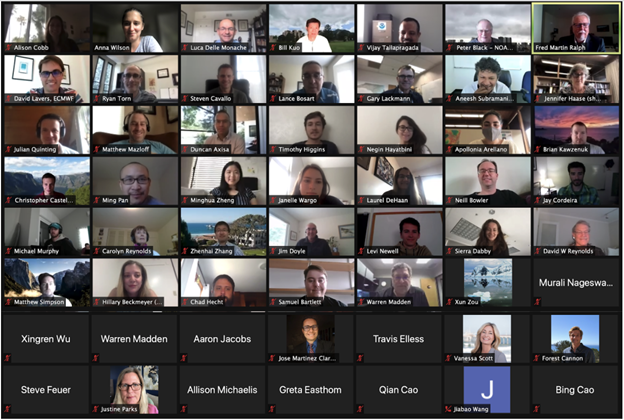CW3E Hosts Second Annual Atmospheric River Reconnaissance (AR Recon) Workshop
July 20, 2021
The second annual Atmospheric River Reconnaissance (AR Recon) Workshop was held virtually from 8-11 am Pacific Time each morning June 28 – July 1.
The purpose of the AR Recon Workshop was to document impacts and envision AR Recon out to 2025. The goals were to share results, to coordinate and inspire future work on data collection, data assimilation, metric development and impact assessment, and to discuss the research and operations partnership approach being developed in AR Recon.
The workshop was organized by the AR Recon Modeling and Data Assimilation Steering Committee. Workshop co-chairs were CW3E Director Marty Ralph, Chief of the Modeling and Data Assimilation Branch of the Environmental Modeling Center at NCEP Vijay Tallapragada, and Naval Research Laboratory Senior Scientist Jim Doyle. The workshop brought together nearly 100 attendees from leading academic institutions around the globe and US and international agencies to focus on AR Recon and its impact on AR prediction. In addition, the workshop provided an opportunity for students, postdocs, and other early career researchers to participate in developing a road map for future AR Recon efforts.
The meeting began with opening remarks from workshop co-chairs. The first day’s schedule focused on the Research and Operations Partnership and included perspectives from partners in the Air Force and NOAA Aircraft Operations Center. A summary of observations collected as part of AR Recon was presented, which included those from dropsondes, buoys, radiosondes, and Airborne Radio Occultation (ARO).
The second day was focused on AR Recon sampling strategy, with essential atmospheric structures highlighted as the primary target. The use of several different sensitivity tools, based on the Naval Research Laboratory’s adjoint model, and ensemble forecasts from different global operational numerical weather prediction centers, which provide information on locations where additional observations may help to constrain the forecast, was also covered.
On the third day, we heard results of studies looking at the impacts of AR Recon data on forecasts. Exciting results were shared by all modeling centers partnering in the AR Recon Modeling and Data Assimilation Steering Committee, including CW3E, NCEP, ECMWF, NRL, and NCAR. One outcome was the decision to coordinate a case study of a sequence of Intensive Observation Periods (IOPs) to examine in detail.
The final day of the workshop there were facilitated discussions on topics including collaborations with European colleagues to develop AR Recon in the Atlantic, leveraging plans for the North Atlantic Waveguide, Dry Intrusion, and Downstream Impact Campaign (NAWDIC) effort (a follow-on campaign to NAWDEX); sampling strategies thus far and in future; and coordinated case study plans. Excellent progress was made during these discussions and follow up activities are planned on all topics.
Day 1: Session I: AR Recon: Research And Operations Partnership (RAOP)
Day 2: Session II: AR Recon Sampling Strategy: Essential atmospheric structures
Session III: AR Recon Sampling Strategy: Sensitivity tools
Day 3: Session IV: Data Assimilation and Impact Studies
Day 4: Session V: AR Recon Vision – Facilitated Discussions
Throughout, the workshop was very participatory and featured lots of engaged and in depth discussion between the participants.
This workshop integrates several of the CW3E priorities from the 5 year strategic plan including Atmospheric Rivers Research and Applications, Emerging technologies and Modeling capabilities for the Western US.
AR Recon Workshop participants before adjourning the virtual meeting on July 1, 2021.

